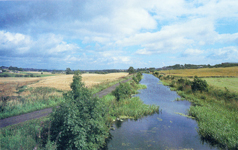“As Dr Hutton always took a warm interest in whatever concerned the advancement of the arts, particularly in his native country, he entered with great zeal into the project of an internal navigation between the Firths of Forth and Clyde”
(Playfair).

Following his period of farming in Berwickshire, Hutton became closely involved with the construction of the Forth and Clyde canal between the years 1767 -1774 during which he put his geological knowledge to commercial use. As a share-holder and member of the canal company’s committee of management he undertook a range of assigned tasks during a staggering total of 84 meetings in seven years – including site meetings which lasted two to three days along the canal route. These were arduous and involved inspections of all the works and depending on progress included locks, aqueducts, bridges and quarries
The canal had a mixed history and in the spirit of all public works even now in 21st century Scotland, its final cost greatly overshot original estimates with its eventual completion in 1790. By 1800 it was carrying 129,480 tons of cargo a year mainly coal, herring, salt, timber, grain and iron with its zenith in 1866 with 2,925,453 tons.
His connection with the canal almost certainly prompted Hutton’s first publication on
“Considerations on the Nature, Quality and Distinctions of Coal and Culm”.
Though published in 1777 it was probably drafted several years earlier. His likely motive was to increase traffic along the canal by persuading the Government to lower the tax on Scottish culm carried by sea. The pamphlet addressed the question
“whether the small coal of Scotland is the same with the culm from England”
and if so, is it entitled to the exemption of duty tax when carried along the coast (and presumably along the canal)? Playfair informs us that
“an exemption from duty was obtained for the small coal of Scotland….owing in great degree to…Dr Hutton’s pamphlet."